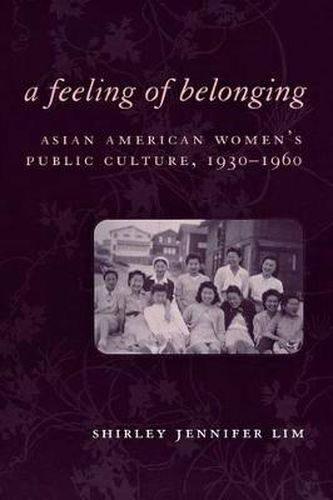Readings Newsletter
Become a Readings Member to make your shopping experience even easier.
Sign in or sign up for free!
You’re not far away from qualifying for FREE standard shipping within Australia
You’ve qualified for FREE standard shipping within Australia
The cart is loading…






When we imagine the activities of Asian American women in the mid-twentieth century, our first thoughts are not of skiing, beauty pageants, magazine reading, and sororities. Yet, Shirley Jennifer Lim argues, these are precisely the sorts of leisure practices many second generation Chinese, Filipina, and Japanese American women engaged in during this time.
In A Feeling of Belonging, Lim highlights the cultural activities of young, predominantly unmarried Asian American women from 1930 to 1960. This period marks a crucial generation-the first in which American-born Asians formed a critical mass and began to make their presence felt in the United States. Though they were distinguished from previous generations by their American citizenship, it was only through these seemingly mundane American activities that they were able to overcome two-dimensional stereotypes of themselves as kimono-clad Orientals.
Lim traces the diverse ways in which these young women sought claim to cultural citizenship, exploring such topics as the nation’s first Asian American sorority, Chi Alpha Delta; the cultural work of Chinese American actress Anna May Wong; Asian American youth culture and beauty pageants; and the achievement of fame of three foreign-born Asian women in the late 1950s. By wearing poodle skirts, going to the beach, and producing magazines, she argues, they asserted not just their American-ness, but their humanity: a feeling of belonging.
$9.00 standard shipping within Australia
FREE standard shipping within Australia for orders over $100.00
Express & International shipping calculated at checkout
When we imagine the activities of Asian American women in the mid-twentieth century, our first thoughts are not of skiing, beauty pageants, magazine reading, and sororities. Yet, Shirley Jennifer Lim argues, these are precisely the sorts of leisure practices many second generation Chinese, Filipina, and Japanese American women engaged in during this time.
In A Feeling of Belonging, Lim highlights the cultural activities of young, predominantly unmarried Asian American women from 1930 to 1960. This period marks a crucial generation-the first in which American-born Asians formed a critical mass and began to make their presence felt in the United States. Though they were distinguished from previous generations by their American citizenship, it was only through these seemingly mundane American activities that they were able to overcome two-dimensional stereotypes of themselves as kimono-clad Orientals.
Lim traces the diverse ways in which these young women sought claim to cultural citizenship, exploring such topics as the nation’s first Asian American sorority, Chi Alpha Delta; the cultural work of Chinese American actress Anna May Wong; Asian American youth culture and beauty pageants; and the achievement of fame of three foreign-born Asian women in the late 1950s. By wearing poodle skirts, going to the beach, and producing magazines, she argues, they asserted not just their American-ness, but their humanity: a feeling of belonging.